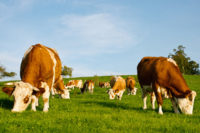
While increased spending on automation and higher levels of plant hygiene is what you can expect to see in place in more food plants in the 21st Century, recent consolidations and economic turmoil did not hinder our efforts to uncover over 525 projects planned or underway in 2001. The need for food plants to remain flexible is proven by the statistics of this survey: plant renovations and expansions outnumbered greenfield projects by a margin of about three to one.
“Flexibility is probably the biggest trend in new food plant construction,” according to Yorgos Papatheodorou, manager of strategic and market development for Lockwood Greene. “With new products proliferating and old ones discontinued, facilities need to accommodate multiple lines and allow quick changeovers.” Papatheodorou predicts that automation in both production and logistics will increase in the near future.
Jeff Jendryk, vice president of McClier’s food and beverage group, agrees that flexible facility design is an emerging trend, but he also sees sanitary facility design just as important. “For example, piping systems are being placed outside of the processing areas,” he says. “Because food safety and quality issues are receiving more attention, facilities are looking for a higher quality of design and construction material to improve the overall quality of their products.”
According to Tom Dennis, owner/president of The Dennis Group, automation and robotics, better quality sanitary environments, tighter environmental controls and product quality improvement projects are the top emerging trends in food plant construction. He attributes these trends to the food manufacturers’ need to compete by delivering a high quality, safe product.
“The most dynamic and pervasive trend affecting construction as well as every other facet of food processing is the growing emphasis on food safety, said Tom Barr, vice president/operations engineering for A. Epstein and Sons International. The impact on construction includes more site safety precautions along with improved monitoring of both plant personnel and food processing areas.

Red light for greenfield
Employment and worker training issues continue to be of great concern to food plant managers across the US, causing some manufacturers to shy away from greenfield projects. “With the short life cycle of new products and the high cost of locating and building new facilities, food producers tend to capitalize on their existing facilities and workforce to address the changing market demands,” said Jendryk.
There are existing facilities where greater value can be derived by leveraging off existing infrastructures and assets, says Dennis. Most architectural and engineering firms agree that retrofits or expansions can be very cost-effective. “Speed to market of a retrofit project or purchasing an existing building is a big advantage,” said Mark Shambaugh, CEO of Shambaugh & Son. However, he cautions that depending on the past and planned function of the site, the cost savings of a retrofit may not be significant upon deeper review.

However, the urge to merge may have hidden benefits for food companies looking for existing facilities. “With all the merger and acquisition mania,” says Scott Pribula, vice president of Stahlman, “there are a lot buildings available due to downsizing or consolidation.”
Sanitation and safety rule
Without a doubt, new food industry regulations have an enormous impact on plant construction projects. “HACCP has sustained and invigorated a pre-existing trend toward more food sanitary facilities with deliberate design focus and with the highest priority given to food safety,” according to Dennis.John Miller of Seiberling says new food industry regulations have influenced new food plant projects in terms of upgrading processes to achieve better and more automatic cleaning. New regulations mean attention to material selection and more attention to detail, according to Scott Pribula. “For example, more drains are installed (no standing water), more air changes, higher filtration rates, tighter control on temperature fluctuations from process to end user.”
Fru-Con’s Jerry Miller concurs, saying that many of the new food industry regulations are more exacting, resulting in an expanded scope for food plant construction projects. Mark Shambaugh sees more stringent clean design and plant operating criteria as a continuing trend. Previously less stringent food markets are adapting clean design protocol from other food markets that were long accustomed to higher levels of hygiene, he said.
Irradiation is a new issue for most food plants, and construction projects need to address the material handling and safety questions associated with it. “A plant’s layout and ultimate construction would be specifically impacted by this technology,” said Barr. Similarly HACCP rules could impact the construction to meet inspection requirements, he adds. “Looking ahead, food safety issues will dictate the most radical changes in terms of plant construction, site selection and site development.”
The following companies assisted Food Engineering
in compiling this survey:
The Austin Company
Kathleen M. Bast
440-544-2633
Case, Lowe & Hart, Inc.
Kevin Lewis
801-399-5821
The Dennis Group
Tom Dennis
413-787-1785
A. Epstein and Sons International, Inc.
Andrea Velasquez
312-429-8319
Facilities Design Group
Joe A. Shaffer
717-285-9442
The Facility Group
Tiffany Baxter
770-437-2700
FoodPro International
Bill Washburn
408-227-2332
Fru-Con Construction Co.
Jerry Miller
636-391-4570
Gleeson Constructors, Inc.
Harlan J. VandeZandschulp
712-258-9300
The Haskell Company
Darryl Wernimont
904-791-4500
Hendon & Redmond
Ted Montag
513-641-0320
Hixson
Michael J. Steur
513-241-1230
Lockwood Greene
Yorgos Papatheodorou
864-599-4489
McClier
Jeffrey P. Jendryk
312-373-7700
Middough Associates Inc.
Ron Mobley
630-734-7005
Seiberling Associates Inc.
John Miller
614-764-2817
Shambaugh & Son
Mark Shambaugh
219-487-7807
Stahlman Engineering
Scott Pribula
603-526-2585
The Stellar Group
Mark Sherwood
904-260-2900
St. Onge, Ruff & Associates
Kelly Snelbaker
717-854-3861
Suitt Construction
Company Inc.
Don White
864-250-5062
Webber/Smith Associates
Ben Webber
717-291-2266
Westra Construction Inc.
Peter G. Roehrig
920-324-3545 ext. 149
Younglove
Michael D. Rueckert
712-277-3906




